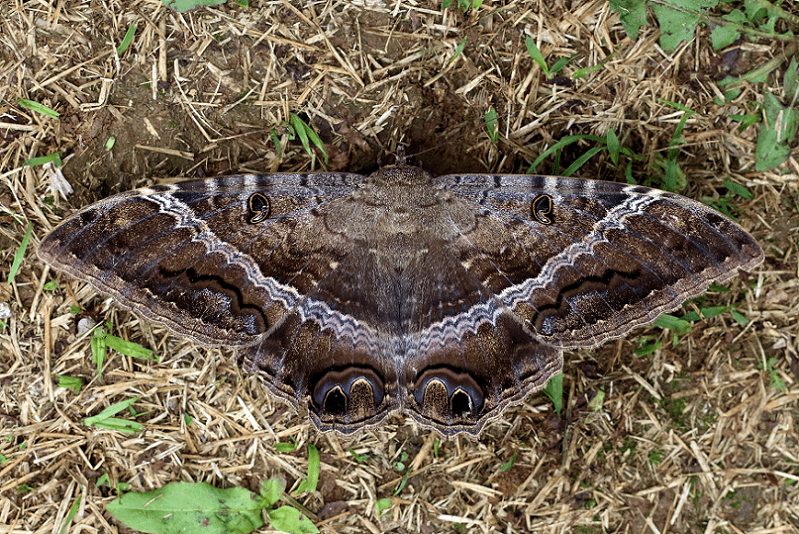Black Witch Moth Facts
- This visually stunning Lepidoptera probably remains best known by the common name of the Black Witch Moth. In other languages, though, this marvel’s typically much better known by such other terms as La Sorcière Noire, in French, and Mariposa de la Muerte, in Spanish.
- Its official scientific name, however, remains that of the tongue-twisting Ascalapha odorata, one hard for the layperson to pronounce. By whichever term one chooses to refer to it, though, its stands apart from many of its related species. It also does so for more than one reason.
- The impressive invertebrate also owes its place in the annals of entomology due to the actions of someone well known in the field. That’s because the highly respected Swedish entomologist, Carl Linnaeus made the first formal recognition of it as a species, back in the year 1758.
- Unfortunately, in some cultures within a part of its greater range, it has also long been associated with either misfortune or death in superstition. The precise reason for this, however, eludes most modern researchers. The reputation is, of course, completely unfounded.
- Fortunately, the marvelous Black Witch Moth also appears to be maintaining a population base that’s both stable and sufficinet. The IUCN, therefore, currently has no listing for the beautiful insect on the organizations Red List of Threatened Species of Threatened Species.
- Despite this fortunate situation, though, the wonder of Nature and evolution must be considered to be facing at least some potential risk. This holds true due to a combination of two factors. Throughout its range, both habitat loss and climate change continue to escalate.
Related Articles
Black Witch Moth Physical Description
Most of its numerous relatives around the world seem content to impress observers based on one trait alone, but not the magnificent Black Witch Moth. That’s because this Lepidoptera merits appreciation due to both its appearance and size. This insect shines in terms of both attributes.
Like many of those kindred creatures, this awesome Arthropod displays the physiological trait of sexual dimorphism. In its specific case, however, it manifests this trait in two separate ways. Those ways, not surprisingly, happen to be in terms of both its sheer wingspan and visual uniqueness.
It’s in terms of sheer wingspan, though, that it displays its gender-based difference in the fact that males typically develop a lesser span than females. The larger females, though, sometimes attain a truly incredible width. More precisely, their wings can span as much as 6.7 in (17 cm) across.
The sex-based differences presented by the stunning Black Witch Moth also present themselves in terms of coloring. Females of the species, in addition to being slightly larger, also develop a notably lighter color. The males, meanwhile, predominantly present a much darker black background.
Both genders of this invertebrate additionally develop one specific shared trait. That’s the presence of a light brown on the dorsal part of the wings. This is frequently accompanied by a mottling of almost iridescent shades of pink and purple. Females, however, sometimes show a thin white bar.
- Kingdom: Animalia
- Phylum: Euarthropoda
- Class: Insecta
- Order: Lepidoptera
- Family: Erebidae
- Genus: Ascalapha
- Species: A. odorota
Black Witch Moth Distribution, Habitat, and Ecology
The breathtaking Black Witch Moth possesses yet another natural attribute fully worthy of respect. That’s the fact that it evolved as indigenous to a comparatively broad section of the globe. This range, in fact, extends through portions of both the Northern and Southern Hemispheres.
More precisely, the southern end of that territorial range extends as far to the south as the country of Argentina, in South America. From there, its territory extends northward, through Central America, Mexico, and into the southern portions of the United States, in North America.
During the late Spring and Summer seasons, the marvelous Arthropod typically migrates northward. It sometimes even does so over incredibly vast distances. At this time, it usually moves from Mexico to the continental United States. A few scattered individuals have been even seen in Hawaii.
Like most animals, it displays decidedly strong and clear preferences regarding its choice of habitat. It favors tropical and subtropical environments, especially areas with dense vegetation. It’s usually found in areas of woodlands, forests, gardens, and agricultural areas where host plants appear.
In terms of its basic nature, the stunning moth evolved as primarily nocturnal, like most. It therefore most commonly forages for its food at night. Interestingly, adult specimens most frequently feed on overripe fruit, usually bananas. The larva also generally consumes plant leaves voraciously.
As with most recognized species of Lepidoptera, its adult life cycle evolved to be extremely short. A typical lifespan for the fabulous Black Witch Moth usually equals no more than a few weeks. Meanwhile, being nocturnal, its principal predators typically include various types of owl and bats.
Species Sharing Its Range
Check out our other articles on 3 Wondrous African Woody Shrubs, Hyacinth Macaw, Victoria Falls, South American Sea Lion, Spiny Dogfish, Orange-belted Bumblebee, Satanic Leaf-Tailed Gecko

